Have you ever used Starbucks credit points to get a free beverage? In case you were wondering how that happened, you have already experienced gamification.
With gamification mechanics, brands are earning customer loyalty and scaling their business profitably. Using a gamification application elevates brand experience and piques consumer interest as they know they'll earn loyalty points or rewards.
Brands pivoting to smart digitization are mostly switching to gamification software to integrate interactive graphics and animations into their websites and nudge customers in the right direction.
What are the most common examples of gamification?
The most common examples of gamification are points systems, achievement badges, leaderboards, progress bars, daily challenges, and virtual rewards. Organizations also apply gamification through levels, quizzes, and interactive storytelling to boost engagement, learning, and user retention.
Many non-gaming domains, such as education, e-commerce, banking, retail, food, beverages, and so on, are creating gamification strategies to personalize their websites and stand out from the rest of the players.
Brands utilize gamification to increase user retention, gather behavioral data, and boost customer lifetime value (CLV).
TL;DR: Everything you need to know about gamification
- What it is: Gamification integrates game-like mechanics, such as points, badges, leaderboards, AR, quizzes, and rewards, into digital and real-world environments to engage users and influence behavior.
- Why it matters: It drives customer loyalty, boosts conversions, and deepens emotional connection by triggering reward-seeking and competitive instincts.
- Where it’s used: Marketing, loyalty programs, employee engagement, microlearning, e-commerce, wellness apps, and brick-and-mortar retail.
- Real-world examples: Duolingo, Fitbit, Starbucks, Nike Run Club, and Uber have successfully used gamification to fuel engagement and business growth.
- Top software picks: G2 Grid leaders in gamification software include Hacker Rangers, Centrical, Spinify, Komo, and Rallyware.
Let's learn how gamification not only offers a fun and interactive experience but also triggers consumer emotions with some gamification elements.
What are popular gamification elements?
Gamification isn't limited to points and badges, but it’s a rich system of mechanics, dynamics, and psychological triggers designed to drive action and loyalty. When used intentionally, these elements can transform a passive user into an engaged participant, guiding them through your product, site, or campaign with purpose.
Let’s break down the most popular gamification elements that brands are embedding into everything from marketing campaigns to mobile apps to enterprise software platforms.
| Element |
Psychological trigger |
Common use cases |
| Points & coins |
Accumulation & progress |
Loyalty programs, fitness apps |
| Badges & achievements |
Recognition & mastery |
Social apps, education, and onboarding |
| Leaderboards |
Social comparison & competition |
Sales teams, fitness groups |
| Progress bars & streaks |
Completion urge (Zeigarnik) |
Learning apps, onboarding, wellness tracking |
| Challenges & quests |
Goal setting |
Fitness, referral programs, engagement campaigns |
| Spin-to-Win |
Surprise & curiosity |
E-commerce, promotional events |
| AR / Mini-Games |
Immersion & novelty |
Marketing activations, retail experiences |
| Social Sharing |
Peer approval |
All verticals, especially B2C |
| Personalization |
Intellectual engagement |
EdTech, lead generation, product discovery |
When thoughtfully combined, these elements can turn ordinary user journeys into engaging, habit-forming experiences. The key is to align each mechanic with your audience’s motivations and your business goals.
What are the top gamification examples over the years?
Let's peek into a few famous gamification examples across different companies:
1. Fitbit
Fitbit is a consumer electronics brand that markets its wireless wearables and other gadgets through gamification. You can easily monitor your overall health by downloading the Fitbit fitness app and syncing it with your Fitbit device, say, a smartwatch, via Bluetooth. The device features a visual display that tracks your steps, spO2 levels, burned calories, and many other bodily functions.
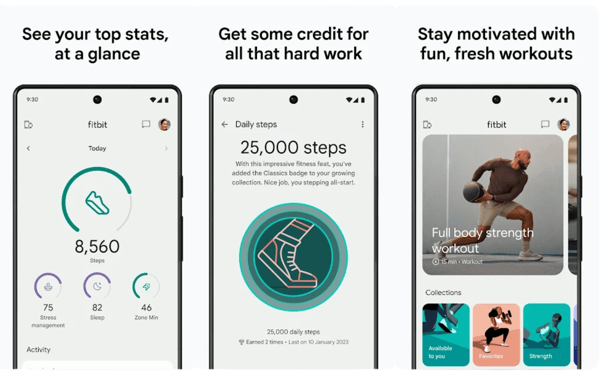
Source: Google Play
Fitbit doesn’t just track steps; it turns your fitness journey into a visual game. With real-time feedback, streak tracking, and virtual badges, it’s designed to nudge you toward healthier habits without feeling like a chore. It maintains a calendar-wise workout activity and tracks your everyday progress via real-time analytics. The app also contains user rewards for those who remain consistent with their exercise routines.
In summary, Fitbit provides intrinsic motivation to walk regularly, shed extra pounds, and stay healthy.
2. Nike Run Club
The Nike Run Club uses game elements to display the distance you ran or walked, personalize workout suggestions, and suggest good articles. Nike Run Club turns solo workouts into something social. With personalized coaching, achievement unlocks, and community-driven challenges, it’s motivation in your pocket
During the lockdown, the number of downloads of Nike Run Club hit 15.4 million as user engagement peaked.
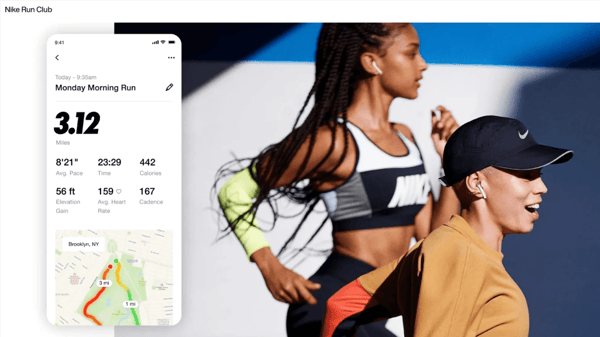
Source: Nudge
Nike's run club worked by the book of psychology to make a person aware of their desires. It captures users' data like activity levels, weight, and personal interests to craft creative workout reminders. In the same vein, Nike also uses this platform to promote advertisements, which sets the backdrop for its sales growth.
Users can validate their efforts by sharing their accomplishments via social media while working on their fitness targets.
3. Duolingo
Keeping up with the communication barriers we face, Duolingo developed a unique language learning app that works on gamification. The developers of Duolingo launched 98 educational courses that taught 39 new languages, representing every major country in the world. Duolingo's main interface comprises animated characters and color pops to catch your maximum attention.
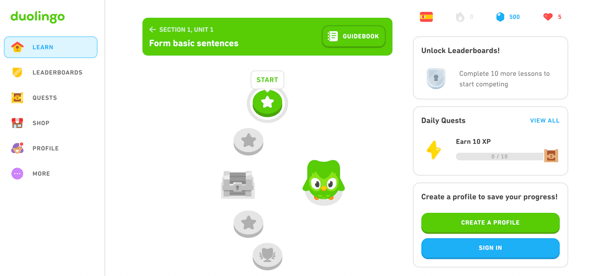
Source: Duolingo
Based on the Octalysis gamification framework, the app analyzes human sentiments and learning patterns to create attractive reward packages. For every course you take, there is a hidden reward in the form of badges or coins. It also triggers funny notifications that remind you to complete the course and become a language expert.
%20(1)-png.png?width=600&height=660&name=Copy%20of%20Cycle%20(6)%20(1)-png.png)
Duolingo's gamification approach might seem a hindrance to some, but it made others feel valued and wanted. Duolingo's strategy of keeping a prospect as the center of focus earned them a revenue fortune.
4. KFC
A Japanese Kentucky Fried Chicken or KFC outlet promoted their newest line of shrimp food items via gamification. In collaboration with Nintendo, the game designers, KFC created "Shrimp Attack." To win this game, users had to defend a KFC castle by slicing as many shrimps as they could, just like a Fruit Ninja.
Anyone who visited the KFC website could play it for free and earn reward coins for discounted meal combos at the nearest KFC outlet. Initially struggling to attract customers, the brand suddenly saw a 22% increase in game registrations. Eventually, KFC witnessed a spike of 106% in its overall sales growth.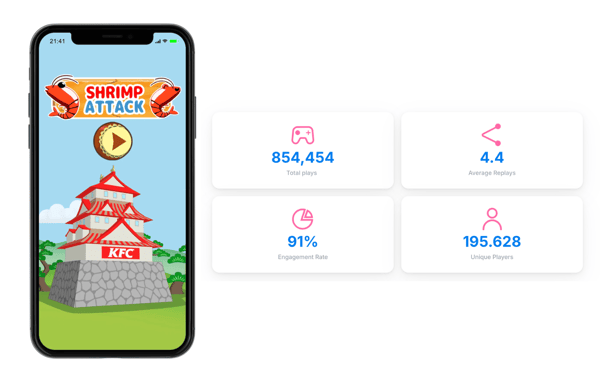
Source: Gamify
5.M&M
M&M's eye spy pretzel game is one of the most famous examples of gamification and how one should use it. When M&M released a new pretzel-flavored chocolate, it decided to advertise it using gamification. They launched an eye-spy game for consumers. Like Candy Crush, they had to find one hidden pretzel among thousands of M&Ms placed inside a rectangular box.
This simple but inquisitive game brought tangible benefits to the campaign, along with increased sales and ARR growth for M&M. The brand's Facebook page got 25,000 new likes, 6,000 shares, and 10,000 comments. M&M's initiative to engage with social media users and spread the launch buzz won the praise of every marketer.
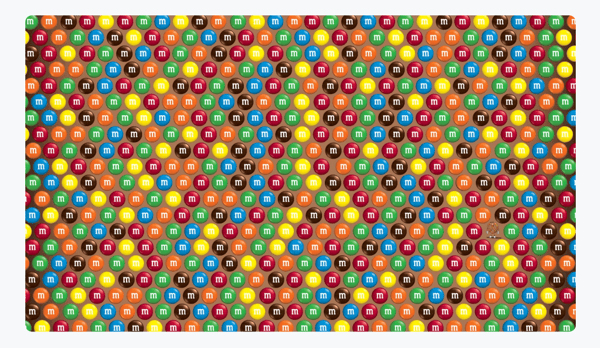
Source: Tidio
6. Coca-Cola and Nescafé
Both Coca-Cola and Nescafé leveraged gamification to elevate the in-store product experience. In partnership with Ksubaka (a personalization engine), they created immersive "Moments of Joy" for their consumers. If consumers were a few feet away from the product shelf, their smartphones captured MoJo signals.
As the user clicks on the notification, the brand prompts him to complete a call to action before claiming the reward. The step could be anything, like filling out a survey form or liking a social media post. This way, both brands earned numerous likes and shares, which aided in higher conversions.
Coca-Cola, in particular, also came up with the idea of a gamified vending machine in which, if you hug a machine, scratch a card, or say a different phrase to it, it would reward you with a free can of the soft drink.
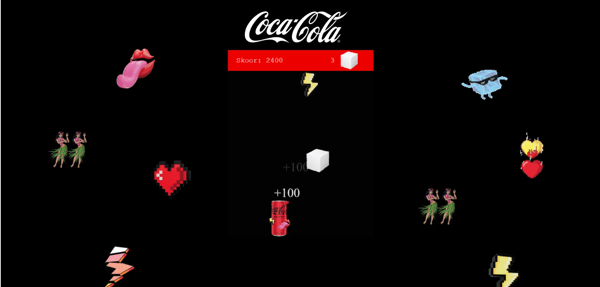
Source: adact
7. Pepsi Max
Pepsi Max unfurled the next generation of gamification through their BTL marketing campaigns. They created a 3D simulation of a virtual dragon shooting lasers or a tiger charging at passengers waiting at a London bus stop using augmented reality technology.
This experience was horrifying but entertaining at the same time. It also established Pepsi Max as a trendsetter in Martech.
Source: YouTube
8. Starbucks
Starbucks doesn’t just gamify for fun, it uses it to quietly build repeat habits that drive massive retention. With the "My Rewards" program of the Starbucks application, customers earn a few stars or points every time they place an order. On completion of a specific number of stars, consumers are entitled to discounted vouchers at the nearest coffee outlet. Most Starbucks visits are further upgraded with a free coffee or a sandwich.
Starbucks' application also has a seamless digital interface with integrated features like online ordering, pay later, and customized music playlists via Spotify. Whether creating the world's best coffee or providing the best user experience, Starbucks is a master of the game.
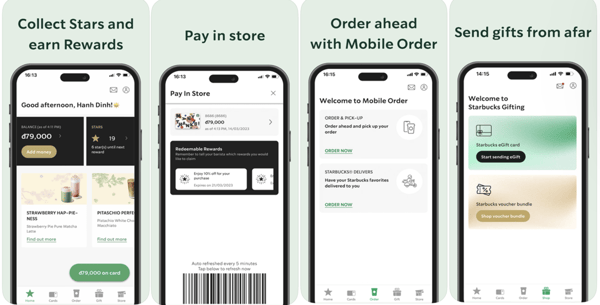
Source: smartdev
9. Headspace
Today, we run a rat race for money but forget what we lose. Headspace is a mental health and wellness app that brings back the lost charm of a positive mindset.
The app features guided meditation, games, and other recreational activities for users to unwind at the end of a hectic day. Using game-style design illustrations and graphics shocks the user's system and reminds them of what is essential to lead a happy life. People across every age group can explore Headspace in different ways to soothe themselves, reduce anxiety, and engage with fellow enthusiasts.
Headspace rewards users for consistently attending their meditation sessions and motivates them to keep at it. The rewards are later claimed in cashback, extended membership, mindful playlists, and other perks.
 Source: headspace
Source: headspace
10. Uber
The Uber app uses gamification from a business perspective. A reward system or ludic loop is activated at the driver's end, which tracks the driver's efficiency and progress throughout the day.
The Uber rewards program, launched in 2018, also includes a tier system that unlocks different rewards and incentives for drivers. For example, if a potential rider cancels on the driver deliberately, the driver wouldn't be charged any cancellation fee. Further, the cancellation fee levied on the next rider will also be transferred to the driver without cutting parts in commission.
Uber's strategic program aims to retain its driver base and stabilize its employee workforce.
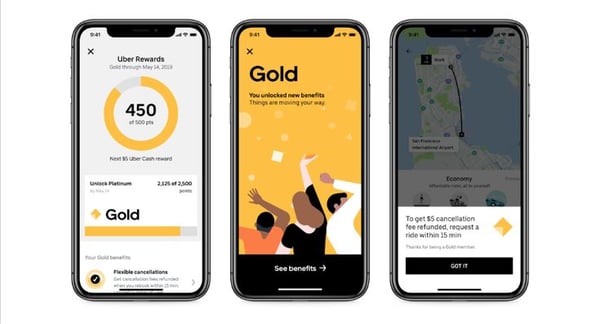
Source: Pinterest
That small nudge, the streak reminder or reward badge, isn’t random. It’s neuroscience. It’s a rare example of gamification used not to sell, but to retain.
Gamification isn’t about games, it’s about behavior. From fitness and food to learning and logistics, these examples show how thoughtful game design transforms ordinary user journeys into sticky, memorable experiences
$29.11 Billion
The market size of the gamification market in 2025 is projected to reach $92.51 billion by 2030, at a CAGR of 26.02%.
Source: Mordor Intelligence
Gamification apps used by industries today
Keeping the fire of interest burning might sound easy, but it isn't. The advent of gamification has relaxed the nerves of marketers and advertisers in terms of perpetuating interest. Brands now understand what consumers want: to be heard and prioritized among large numbers.
How did gamification break through traditional marketing barriers to gain worldwide attention? Let's understand how through some applications:
1. Loyalty management
Retailers, travel companies, and restaurants use loyalty management platforms to create friendly and engaging experiences for consumers. Customer loyalty programs can take various forms, from point systems to referral programs to voucher redemptions.
The "reward-seeking" behavior born through loyalty programs can amplify your engagement and nudge prospects toward the proper purchase. It makes customers "curious " to check whether they're liable for new rewards, membership perks, vouchers, or free deals.
Our marketing forefathers said you couldn't have a system to monitor your customers' sentiments and build permanent trust, but now you do.
Best loyalty management software on G2 in 2025
G2 helps businesses choose the right tools to build customer loyalty, reward repeat purchases, and create long-term brand advocates.
Below are the top 5 leading loyalty management software from G2’s Summer 2025 Grid® Report.
2. Employee engagement
Employee engagement platforms can be tricky, but gamifying the process can motivate employees to become more involved. Employee engagement software infuses fun into onboarding, probation, contests, and survey processes. For example, you can award an illustrious employee a badge or milestone in a topper’s leaderboard.
Also, employee engagement is a type of employee gamification example that sustains employee experience in the long run.
Best employee engagement software on G2 in 2025
G2 empowers organizations to find the best tools to boost workplace morale, recognize achievements, and keep employees motivated and connected.
Below are the top 5 leading employee engagement software from G2’s Summer 2025 Grid® Report.
3. Sales gamification
Sales gamification software creates interactive training programs for employees. As your employees ramp up and achieve set sales targets, you can attach incentives or variable amounts to their salaries. This not only appreciates the deserving employee but also sets the stage for future performers.
Best sales gamification software in 2025 on G2
G2 allows sales teams to discover the most effective tools to drive performance, inspire healthy competition, and keep reps motivated through engaging challenges and rewards.
Below are the top 5 leading sales gamification software from G2’s summer 2025 Grid® Report.
4. Customer advocacy
Customer advocacy, also known as marketing advocacy or referral marketing, is used for customer referrals, account-based marketing, and creating a native buzz about new product lines before advertising them.
Best customer advocacy software in 2025 on G2
G2 helps businesses find the best platforms to turn satisfied customers into brand champions, boost referrals, and amplify positive word-of-mouth.
Below are the top 5 leading customer advocacy software from G2’s Summer 2025 Grid® Report.
5. Microlearning gamification
Company HRs widely use microlearning platforms to create events, games, and interactive presentations. Employees can easily amp up their corporate training by integrating small educational modules into their daily workflows.
These platforms consist of multimedia content, flashcards, and a query management system, to name a few.
Best microlearning software in 2025 on G2
G2 guides teams to identify the top tools for delivering bite-sized, engaging training content that boosts knowledge retention and supports continuous learning.
Below are the top 5 leading microlearning software from G2’s summer 2025 Grid® Report.
Gamification across use cases: quick comparison by business objective
Gamification can be tailored to different contexts, from B2C loyalty to B2B employee training. Below is a comparison table summarizing how gamification plays out across key business use cases:
| Use case |
Primary audience |
Common goals |
Gamification tactics |
Representative tools |
| Consumer engagement |
End users / shoppers |
Drive brand interaction & product awareness |
Mini-games, AR, points for actions, spin wheels |
Gamify, Upshot.ai, MoEngage |
| Loyalty programs |
Customers |
Increase retention & repeat purchase |
Points systems, tiered rewards, badges, streaks |
Emarsys, Xoxoday Plum, Zinrelo |
| Employee engagement |
Internal workforce |
Boost morale & productivity |
Leaderboards, badges, training challenges, milestone rewards |
Bonusly, Lattice, Xoxoday Empuls |
| Shopper marketing |
In-store shoppers |
Increase foot traffic & in-store actions |
Proximity-triggered games, scratch-to-win, vending machine gamification |
Ksubaka, Coca-Cola MoJo, EnGaming |
| Sales enablement |
Sales teams |
Improve quota attainment & motivation |
Competitions, performance dashboards, milestone-based incentives |
Ambition, Spinify, Zoho CRM |
| Learning & development |
Employees / customers |
Reinforce knowledge and skill-building |
Microlearning modules, quizzes, flashcards, scenario-based quests |
EdApp, Kahoot!, Axonify, Spekit |
Understanding how gamification works across use cases helps tailor tactics to context, and ensures you're not just adding games, but designing for outcomes
How can you measure gamification ROI?
To move beyond novelty and into strategy, you need to tie your strategy to clear gamification KPIs and ROI. Below are the key metrics that brands use to measure the success of gamified experiences, and the retention improvement they can expect:
- User engagement rate: Gamification increases how frequently and deeply users interact with your platform or product. Look at metrics like session duration, number of interactions per visit, and completion rates for tasks. A spike in these numbers signals that users are finding the experience more rewarding.
- Conversion rate lift: Game mechanics like quizzes, reward prompts, or spin-to-win wheels can drive higher conversion rates across key CTAs. Whether it's email sign-ups, purchases, or app downloads, gamified flows often outperform static funnels by reducing friction and adding motivation.
- Retention & repeat usage: Progress tracking, streaks, and milestone rewards create habit loops that keep users coming back. Metrics like Daily Active Users (DAU), Monthly Active Users (MAU), and cohort retention rates help quantify stickiness over time.
- Referral & advocacy volume: Gamified referral programs and social sharing incentives encourage users to spread the word. Brands often see increases in user-generated content, social mentions, and share-driven traffic after implementing reward-based viral loops.
- Time to first key action (TTFKA): Gamification can reduce the time it takes users to reach their “aha” moment by making onboarding more interactive and goal-driven. Tracking this metric helps ensure your experience delivers early wins and minimizes churn.
- Employee productivity & engagement Scores: Internally, gamification can elevate employee morale and performance. Use engagement surveys, task completion rates, and performance metrics like sales closed or training completed to track effectiveness across teams.
- Customer lifetime value (CLV): Over time, gamified loyalty programs can increase average spend and purchase frequency. Tracking CLV pre- and post-gamification helps quantify long-term ROI on engagement investments.
For best results, align gamification metrics to specific campaign goals or business KPIs, then A/B test variations to refine what actually drives impact.
What are the most effective gamification tools on G2?
The best gamification tools on G2 are visually engaging and deeply integrated with performance analytics, automation, and personalization.
Here are five standout platforms on G2’s 2025 Summer Grid Reports that are setting the standard for gamification-driven results:
1. Hacker Rangers
Hacker Rangers is a gamified learning platform that transforms cybersecurity training into interactive, mission-based challenges. By blending real-world scenarios with game mechanics, it engages users to build practical skills, enhance awareness, and foster a security-first culture across organizations.
What G2 users like best:
"Our employees really appreciated the interactive and gamified format. Many highlighted how accessible the content was, even for people without technical backgrounds. It made learning about cybersecurity enjoyable and approachable, which boosted engagement. Several teams even created friendly competitions around it!"
- Hacker Rangers Review, Emmanuel C.
What G2 users dislike:
"Actually, Hacker Rangers has focused only on cybersecurity and data protection. I’d like to see a wider range of topics being explored. Another point is the frequency of use — the game could include more seasons to keep users continuously engaged"
- Hacker Rangers Review, Cibele S.
2. Centrical
Centrical blends gamification with real-time coaching and personalized learning paths. Its mission-based interface, dynamic feedback, and CRM integration make it ideal for keeping hybrid teams focused and productive, without losing motivation.
What G2 users like best:
"The gamification strategy that Centrical uses to improve employee engagement impressed me most about this company. We can set individual goals unique to the group and can track them in an interesting manner, which keeps the individuals motivated. The seamless integration with our CRM and HR systems makes it easy to set and monitor goals. The real-time feedback mechanism has been very helpful as it has helped us increase productivity and has kept the team’s morale high."
- Centrical Review, Marina L.
What G2 users dislike:
"Overall, there is not much I dislike; however, I would like to see more products relating to the simulations."
- Centrical Review, Ockert S.
3. Spinify
Spinify turns KPIs into game-like dashboards with leaderboards, celebrations, and competition templates. Reps can track their performance in real time, while managers get built-in visibility and morale boosters all in one tool.
What users G2 like best:
"We have unlimited ways to customize data, and we keep it running on large screens in our office to display several key metrics. Members of the sales team have said they feel it's motivating to walk in each morning & see how they are doing. I think aesthetically, it looks better than the competition. Easy to navigate in terms of set-up and maintenance."
- Spinify Review, Beth S.
What G2 users dislike:
"We're limited by our own creativity in some respects. Our account rep Peejay is awesome at helping us roll the tools out, but I know we'd get more value if I prioritised new competitions or content more often."
- Spinify Review, Leonie O.
4. Komo
Komo is a no-code platform that helps brands create interactive, gamified microsites to engage audiences.
It combines content creation, rewards, and data capture in one place, making it easy to run campaigns that boost customer participation and loyalty.
What G2 users like best:
"KOMO is a great platform for customer engagement. It has a wide and ever-expanding variety of games to engage customers. The support team at KOMO are very responsive and helpful when any questions or issues arise. It has been a fundamental platform in re-engaging our customers!"
- Komo Review, Hannah M.
What G2 users dislike:
"Our primary point of friction with KOMO has been deadlines for our team. Our events typically have a near infinite amount of moving pieces and with more lead time we would be able to secure more sponsorship buy in on customizable KOMO pieces."
- Komo Review, Chris D.
5. Rallyware
Rallyware is a performance enablement platform that delivers personalized learning, training, and engagement programs to distributed teams.
It uses data-driven insights to provide the right activities at the right time, helping organizations boost productivity, retention, and overall business results.
What G2 users like best:
"Rallyware has a great support team for all of our markets. They are constantly collecting needs from the markets and helping them customize the platform to meet specific needs."
What G2 users dislike:
"When the business is hierarchy-dependent, such as direct sales, uplines expect to extract reports from the platform to see how their downlines are doing. At the moment, this functionality is limited. However, on the corporate side, we are able to extract reports from the platform dashboard."
- Rallyware Review, Gabriela V.
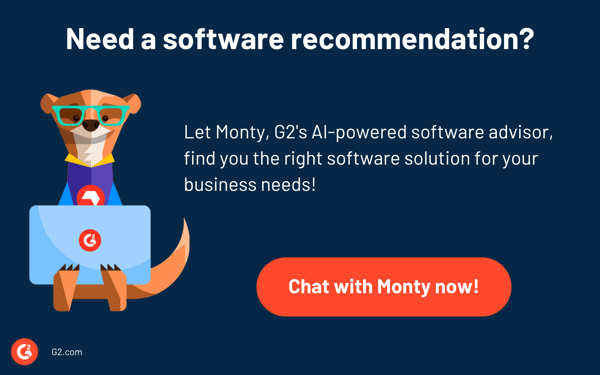
Gamification: Frequently asked questions (FAQs)
Have more questions? We have the answers.
Q1. What is gamification in marketing?
Gamification in marketing uses game-like elements: points, challenges, rewards, to engage customers and influence behavior. It blends fun with strategy to boost participation and brand loyalty.
Q2. What mechanics work best for customer loyalty?
Point systems, tiered rewards, achievement badges, and referral incentives work best. Combining tangible perks with a sense of progress keeps customers engaged longer.
Q3. How has gamification improved brand results?
Brands report higher engagement rates, longer customer retention, and increased sales through gamification. It turns passive audiences into active participants.
Q4. What KPIs should you track for gamified campaigns?
To measure the impact of gamification, track engagement rate, completion rate, repeat participation rate, conversion rate, and average customer lifetime value.
Q5. Is gamification effective for e-commerce?
Yes, gamification boosts conversions, increases time on site, and encourages repeat purchases through rewards, challenges, and exclusive offers.
Q6. Can internal teams use gamification for productivity?
Absolutely, companies use gamification to improve team collaboration, track performance, and motivate employees through leaderboards, milestones, and recognition rewards.
And the gaming saga continues
Driving your customer acquisition via gamification might cause initial budget tightness or untimely expenses, but over time, it will be converted into higher customer ROI and CLV, which will echo your significance in the public market. Making experiences fun and engaging with gamification is a brand card that you can pull to launch a league of your own and make a difference.
With gamification, you make your customers believe that they matter to you and you'd love them to be a part of the larger brand cause and initiative.
Learn about how mixed reality revolutionizes gamification by blurring the lines between the physical world and the computer-generated artificial world.
This article was originally published in 2022. It has been updated with new information.
.png?width=400&height=150&name=Copy%20of%20G2%20Image%20(1).png)
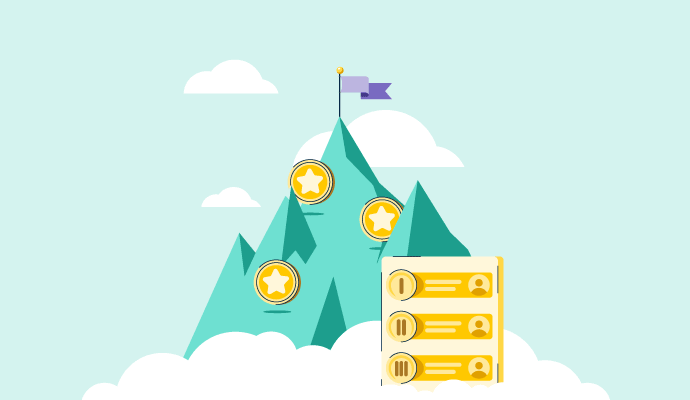



%20(1)-png.png?width=600&height=660&name=Copy%20of%20Cycle%20(6)%20(1)-png.png)







.png)



.png)
